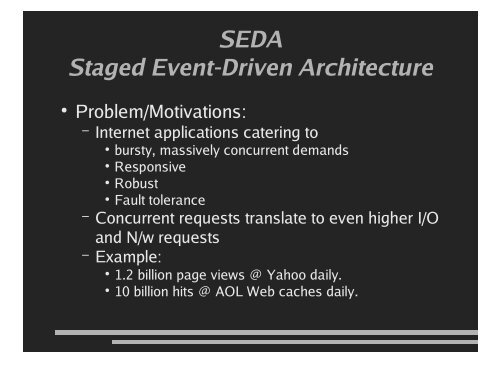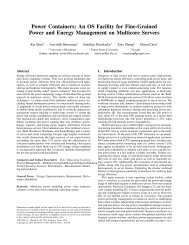SEDA Staged Event-Driven Architecture
SEDA Staged Event-Driven Architecture
SEDA Staged Event-Driven Architecture
You also want an ePaper? Increase the reach of your titles
YUMPU automatically turns print PDFs into web optimized ePapers that Google loves.
<strong>SEDA</strong><br />
<strong>Staged</strong> <strong>Event</strong>-<strong>Driven</strong> <strong>Architecture</strong><br />
� Problem/Motivations:<br />
� Internet applications catering to<br />
� bursty, massively concurrent demands<br />
� Responsive<br />
� Robust<br />
� Fault tolerance<br />
� Concurrent requests translate to even higher I/O<br />
and N/w requests<br />
� Example:<br />
� 1.2 billion page views @ Yahoo daily.<br />
� 10 billion hits @ AOL Web caches daily.
Challenging trends<br />
� Services are becoming complex.<br />
�<br />
� 1. Static content -> Dynamic content<br />
� 2. Deployment issues<br />
� 3. Hosted on general purpose platforms
<strong>SEDA</strong> – A quick intro.<br />
� Provides a general “framework” for authoring<br />
“highly concurrent” & “well-conditioned<br />
service” instances that “handle load<br />
gracefully”.<br />
�<br />
� Traditional OS designs versus <strong>SEDA</strong> design.
<strong>SEDA</strong> – A quick intro (Contd)<br />
� <strong>SEDA</strong> combines:<br />
� Aspects of thread management (Ease of pgmg)<br />
� <strong>Event</strong> based programming model (Concurrency)<br />
�<br />
� Using the <strong>SEDA</strong> framework, applications are<br />
developed as “Network of stages”, each with<br />
an associated incoming queue.<br />
� Java applications based on <strong>SEDA</strong> have<br />
surprisingly outperformed their C<br />
counterparts.
Outline of the rest of the talk:<br />
� Current development frameworks<br />
� <strong>SEDA</strong> Archictecture<br />
� Haboob Http server<br />
� Gnutella p2p file sharing n/w<br />
� Comparison with other architectures<br />
� Conclusion
Terminology<br />
� Well conditioned service:<br />
� A service is well conditioned if it behaves like a<br />
simple pipeline, where the depth of the pipeline is<br />
determined by the path through the network, and<br />
the processing stages within the service itself.<br />
� The key property of a well conditioned service is<br />
“graceful degradation”:<br />
� As the load exceeds capacity, the service maintains<br />
high throughput with a linear response-time penalty<br />
that impacts all the clients equally, or atleast according<br />
to some service specific policy.
Thread based frameworks<br />
� A commonly used<br />
framework:<br />
� Create a new thread<br />
for each request.<br />
� Advantage:<br />
� Easy to program<br />
� Disadvantages:<br />
� Overheads for<br />
cache/TLB misses,<br />
scheduling, lock<br />
contentions.
Possible remedies<br />
� Scheduler activations<br />
� Application-specific handlers<br />
� SPIN<br />
� Exokernel<br />
� Etc<br />
� All attempt to give the applications the ability<br />
to specialize the policy decisions made by the<br />
kernel.<br />
� Bounded thread pools - issues.
<strong>Event</strong> driven concurrency
<strong>Event</strong> driven mechanisms<br />
� These systems tend to be robust to load, with<br />
little degradation in throughput. (Requests vs<br />
<strong>Event</strong>s).<br />
� Excess tasks are absorbed in the server's<br />
event queue.<br />
� Assumption: <strong>Event</strong> handling threads do not<br />
block. Non-blocking I/O must be employed.
Performance
<strong>SEDA</strong> <strong>Architecture</strong><br />
� Goals:<br />
� Massive concurrency<br />
� Well-conditioned service<br />
� Adapt to changing load conditions<br />
� Tune resource management<br />
�<br />
� Stage: A fundamental processing unit.<br />
� Has an incoming event queue, a thread pool,<br />
and an event handler. Each stage also has a<br />
controller for scheduling & thread allocation.
<strong>SEDA</strong>: Stage
Dynamic Resource Controllers<br />
� Goal:<br />
� Shield programmers from performance tuning<br />
�<br />
� Resource controllers:<br />
� Thread pool controller<br />
� Adjust number of threads in the thread pool<br />
� <strong>SEDA</strong> batching controller<br />
� Adjust number of events processed in each invocation<br />
of the event handler.
Sandstorm<br />
� Sandstorm is a <strong>SEDA</strong> implementation in Java<br />
using nonblocking socket i/o (Java NIO<br />
library).<br />
� Each application module implements a simple<br />
event handler – handle<strong>Event</strong>s() which<br />
processes a batch of events from the<br />
incoming queue.<br />
� No worries on thread creation, management.
Sandstorm (Contd)<br />
� Provides Asynchronous network socket layer<br />
based on nonblocking I/O provided by the OS<br />
� AsyncSocket, asyncClientSocket,<br />
asyncServerSocket, asyncConnection etc.<br />
� 3 stages: listen, read, write.<br />
� Provides Asynchronous file I/O layer that uses<br />
blocking OS calls and uses threads to expose<br />
nonblocking behavior.<br />
� AsyncFile (provides non-blocking read, write,<br />
seek, stat etc)
Applications & Evaluation - Haboob<br />
� A high performance HTTP server<br />
� Clients issue http requests & wait for responses<br />
� SPECweb99 benchmark suite used for<br />
performance testing.<br />
� Benefits of using <strong>SEDA</strong>:<br />
� Constructing Haboob increased the modular<br />
design.<br />
� Each stage provides a robust, reusable<br />
component, individually conditioned to load.<br />
� Test different page cache implementations and<br />
file i/o much easily.
Haboob architecture
Haboob (Contd)<br />
� Adaptive load shedding:<br />
� When overloaded, Haboob adaptively sheds load.<br />
� The queue threshold is reduced of that particular<br />
stage.<br />
� Example: HttpRecv stage - Error message is<br />
returned to the client.
Haboob performance
Gnutella – A Packet router<br />
� A peer to peer file sharing network.<br />
� Search & download files from other peer<br />
Gnutella users.<br />
� A node discovers others using a discovery<br />
protocol; use ad-hoc multihop routing.<br />
� <strong>Architecture</strong> has 3 stages:<br />
� GnutellaServer stage (Connection handling)<br />
� GnutellaRouter stage (Table, Process, Route)<br />
� GnutellaCatcher stage (Host discovery)
Gnutella<br />
� Load conditioning policies<br />
� Threshold incoming queue.<br />
� Probabilistically drop packets based on queue<br />
length.<br />
� Admit all packets; filter them based on types.
Comparing <strong>SEDA</strong> with others.<br />
� Recent studies indicate <strong>SEDA</strong> to perform<br />
poorly compared to threaded/event-based<br />
systems in C.<br />
� Matt Welsh, counters it:<br />
� Sandstorm implementation was on Linux 2.2, JDK<br />
1.3<br />
� Studies have used different environments, JVM's.<br />
� <strong>SEDA</strong> n/w layer dependent on several<br />
parameters.<br />
� Tuning these parameters can improve the<br />
performance.<br />
� Goal was to show <strong>SEDA</strong> had “acceptable<br />
performance”, while providing good load
Conclusion<br />
� Measurement & Control is the key, as<br />
opposed to fixed resource allocation.<br />
�<br />
� Challenges:<br />
� Detecting overload conditions<br />
� Strategy to counter overload<br />
�<br />
� Maybe use <strong>SEDA</strong> as a new direction in OS<br />
design.




